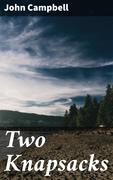Did you mean:
Knapsack15 Results for : knapsacks
-

Algorithm Design: Pearson New International Edition
August 6, 2009 Author, Jon Kleinberg, was recently cited in the New York Times for his statistical analysis research in the Internet age. Algorithm Design introduces algorithms by looking at the real-world problems that motivate them. The book teaches students a range of design and analysis techniques for problems that arise in computing applications. The text encourages an understanding of the algorithm design process and an appreciation of the role of algorithms in the broader field of computer science. Features + Benefits Focus on problem analysis and design techniques. Discussion is grounded in concrete problems and examples rather than abstract presentation of principles, with representative problems woven throughout the text. Over 200 well crafted problems from companies such as Yahoo!® and Oracle®. Each problem has been class tested for usefulness and accuracy in the authors' own undergraduate algorithms courses. Broad coverage of algorithms for dealing with NP-hard problems and the application of randomization, increasingly important topics in algorithms. Algorithm DesignJon Kleinberg and Eva TardosTable of Contents 1 Introduction: Some Representative Problems 1.1 A First Problem: Stable Matching 1.2 Five Representative Problems Solved ExercisesExcercisesNotes and Further Reading2 Basics of Algorithms Analysis 2.1 Computational Tractability 2.2 Asymptotic Order of Growth Notation 2.3 Implementing the Stable Matching Algorithm using Lists and Arrays 2.4 A Survey of Common Running Times 2.5 A More Complex Data Structure: Priority Queues Solved Exercises Exercises Notes and Further Reading3 Graphs 3.1 Basic Definitions and Applications 3.2 Graph Connectivity and Graph Traversal 3.3 Implementing Graph Traversal using Queues and Stacks 3.4 Testing Bipartiteness: An Application of Breadth-First Search 3.5 Connectivity in Directed Graphs 3.6 Directed Acyclic Graphs and Topological Ordering Solved Exercises Exercises Notes and Further Reading 4 Divide and Conquer 4.1 A First Recurrence: The Mergesort Algorithm 4.2 Further Recurrence Relations 4.3 Counting Inversions 4.4 Finding the Closest Pair of Points 4.5 Integer Multiplication 4.6 Convolutions and The Fast Fourier Transform Solved Exercises Exercises Notes and Further Reading5 Greedy Algorithms 5.1 Interval Scheduling: The Greedy Algorithm Stays Ahead 5.2 Scheduling to Minimize Lateness: An Exchange Argument 5.3 Optimal Caching: A More Complex Exchange Argument 5.4 Shortest Paths in a Graph 5.5 The Minimum Spanning Tree Problem 5.6 Implementing Kruskal's Algorithm: The Union-Find Data Structure 5.7 Clustering 5.8 Huffman Codes and the Problem of Data Compression*5.9 Minimum-Cost Arborescences: A Multi-Phase Greedy Algorithm Solved Exercises Excercises Notes and Further Reading 6 Dynamic Programming 6.1 Weighted Interval Scheduling: A Recursive Procedure 6.2 Weighted Interval Scheduling: Iterating over Sub-Problems 6.3 Segmented Least Squares: Multi-way Choices 6.4 Subset Sums and Knapsacks: Adding a Variable 6.5 RNA Secondary Structure: Dynamic Programming Over Intervals 6.6 Sequence Alignment 6.7 Sequence Alignment in Linear Space 6.8 Shortest Paths in a Graph 6.9 Shortest Paths and Distance Vector Protocols *6.10 Negative Cycles in a Graph Solved ExercisesExercisesNotes and Further Reading7 Network Flow 7.1 The Maximum Flow Problem and the Ford-Fulkerson Algorithm 7.2 Maximum Flows and Minimum Cuts in a Network 7.3 Choosing Good Augmenting Paths *7.4 The Preflow-Push Maximum Flow Algorithm 7.5 A First Application: The Bipartite Matching Problem 7.6 Disjoint Paths in Directed and Undirected Graphs 7.7 Extensions to the Maximum Flow Problem 7.8 Survey Design 7.9 Airline Scheduling 7.10 Image Segmentation 7.11 Project Selection 7.12 Baseball Elimination *7.13 A Further Direction: Adding Costs to the Matching Problem Solved ExercisesExercisesNotes and Further Reading 8 NP and Computational Intractability 8.1 Polynomial-Time Reductions 8.2 Reductions via "Gadgets": The Satisfiability Problem 8.3 Efficient Certification and the Definition of NP 8.4 NP-Complete Problems 8.5 Sequencing Problems 8.6 Partitioning Problems 8.7 Graph Coloring8.8 Numerical Problems 8.9 Co-NP and the Asymmetry of NP8.10 A Partial Taxonomy of Hard Problems Solved Exercises Exercises Notes and Further Reading9 PSPACE: A Class of Problems Beyond NP9.1 PSPACE 9.2 Some Hard Problems in PSPACE 9.3 Solving Quantified Problems and Games in Polynomial Space9.4 Solving the Planning Problem in Polynomial Space9.5 Proving Problems PSPACE-Complete Solved ExercisesExercisesNotes and Further Reading 10 Extending the Limits of Tractability 10.1 Finding Small Vertex Covers 10.2 Solving NP-Hard Problem on Trees 10.3 Coloring a Set of Circular Arcs *10.4 Tree Decompositions of Graphs *10.5 Constructing a Tree Decomposition Solved Exercises Exercises Notes and Further Reading11 Approximation Algorithms 11.1 Greedy Algorithms and Bounds on the Optimum: A Load Balancing Problem 11.2 The Center Selection Problem 11.3 Set Cover: A General Greedy Heuristic 11.4 The Pricing Method: Vertex Cover 11.5 Maximization via the Pricing method: The Disjoint Paths Problem 11.6 Linear Programming and Rounding: An Application to Vertex Cover *11.7 Load Balancing Revisited: A More Advanced LP Application 11.8 Arbitrarily Good Approximations: the Knapsack Problem Solved ExercisesExercisesNotes and Further Reading 12 Randomized Algorithms 12.1 A First Application: Contention Resolution 12.2 Finding the Global Minimum Cut 12.3 Random Variables and their Expectations 12.4 A Randomized Approximation Algorithm for MAX 3-SAT 12.5 Randomized Divide-and-Conquer: Median-Finding and Quicksort 12.6 Hashing: A Randomized Implementation of Dictionaries 12.7 Finding the Closest Pair of Points: A Randomized Approach 12.8 Randomized Caching 12.9 Chernoff Bounds 12.10 Load Balancing *12.11 Packet Routing 12.12 Background: Some Basic Probability DefinitionsSolved ExercisesExercisesNotes and Further Reading 13 Local Search 13.1 The Landscape of an Optimization Problem 13.2 The Metropolis Algorithm and Simulated Annealing 13.3 An Application of Local Search to Hopfield Neural Networks 13.4 Maximum Cut Approximation via Local Search 13.5 Choosing a Neighbor Relation *13.6 Classification via Local Search 13.7 Best-Response Dynamics and Nash EquilibriaSolved ExercisesExercisesNotes aAugust 6, 2009 Author, Jon Kleinberg, was recently cited in the for his statistical analysis research in the Internet age. Algorithm Design introduces algorithms by looking at the real-world problems that motivate them. The book teaches students a range of design and analysis techniques for problems that arise in computing applications. The text encourages an understanding of the algorithm design process and an appreciation of the role of algorithms in the broader field of computer science.- Shop: buecher
- Price: 94.99 EUR excl. shipping
-

Two Knapsacks A Novel of Canadian Summer Life
Two Knapsacks A Novel of Canadian Summer Life: ab 4.99 €- Shop: ebook.de
- Price: 4.99 EUR excl. shipping
-

Two Knapsacks
Two Knapsacks - A Novel of Canadian Summer Life: ab 1.99 €- Shop: ebook.de
- Price: 1.99 EUR excl. shipping
-
-
Merrithew Yoga Block For Kids (Orange)
MERRITHEW Yoga Block for Kids (Orange)Our Yoga Blocks for Kids are made from kid-safe, non-toxic and formamide-free materials and the size of the Blocks are perfect for small hands! Using a Yoga block can add balance, support and comfort to a kids' Yoga practice.Develop mind-body awareness earlyBuild strong, flexible bodies that ward off injury and illnessManage stress through breathing and focusIncrease confidence and self-esteemBoost Confidence & EsteemMind-body exercise can help instill a sense of confidence in your child. By encouraging kids to persevere, be patient, and work towards mastering a pose, you can instill self-esteem and a healthy work ethic. Mindful movement can help establish compassion, mindfulness, focus, strength, and flexibility in our little ones.Build Strong Bodies & Healthy DevelopmentMind-body exercise for kids is often considered pre-habilitation, a proactive activity that builds strong, healthy bodies equipped to ward off injury and illness. Talk about the muscles being used during exercise with children to build strength while establishing body awareness and coordination. Small bodies that are strong digest food better, maintain a healthy weight and are better equipped to carry heavy loads, like knapsacks. Bodies also breathe better, work more efficiently and protect fragile jointsMindbody Exercise May Help Kids with Special NeedsMind-body exercise is beneficial for children of all ages, but studies show it is particularly helpful for kids with special needs such as autism and ADHD. A survey of teachers who have incorporated daily mind-body exercise in classrooms of autistic children experienced a reduction in aggression, antisocialism and hyperactivity.MaterialsKid-safe and non-toxicMade from formamide-free foamCare & CleaningKeep this block happy, simply wipe with a cloth dampened with soap and water as needed. Allow blocks to fully dry before using.Storing & HandlingImproper or careless use may lead to injuries. Only complete safe, pain-free exercises.Ensure kids maintain control of their blocks at all times while exercisingKeep away from heat sourcesDo not use if block appears damaged.Tuck it away in a dry spot out of direct sunlight.SPECSLength: 22cm (8.75")Width: 10.5cm (4.15")Height: 7.6cm (3")- Shop: odax
- Price: 34.91 EUR excl. shipping

